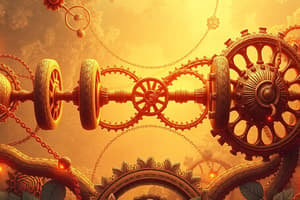Podcast
Questions and Answers
Explain how high-energy electrons are used to transport hydrogen ions across the membrane during electron transport.
Explain how high-energy electrons are used to transport hydrogen ions across the membrane during electron transport.
High-energy electrons passing down the electron transport chain are used to transport hydrogen ions (H+) across the membrane. As the electrons pass down the chain, their energy is used to pump H+ ions across the membrane, creating a charge difference.
What is the role of the inner mitochondrial membrane in the synthesis of ATP?
What is the role of the inner mitochondrial membrane in the synthesis of ATP?
The inner mitochondrial membrane contains enzymes known as ATP synthases, which are responsible for the synthesis of ATP. The charge difference across the membrane forces H+ ions through channels in these enzymes, causing the ATP synthases to spin and produce ATP.
How does the charge difference across the membrane create a biological 'battery'?
How does the charge difference across the membrane create a biological 'battery'?
The charge difference across the membrane, with the intermembrane space becoming positively charged relative to the matrix, creates a biological 'battery' by storing potential energy that can power the synthesis of ATP.
What is the function of ATP synthases in the production of ATP?
What is the function of ATP synthases in the production of ATP?
How do the H+ ions contribute to the generation of ATP during electron transport?
How do the H+ ions contribute to the generation of ATP during electron transport?
How does the inner mitochondrial membrane create a charge difference during electron transport?
How does the inner mitochondrial membrane create a charge difference during electron transport?
What is the role of ATP synthases in the generation of ATP during electron transport?
What is the role of ATP synthases in the generation of ATP during electron transport?
How are enormous amounts of ATP generated during electron transport?
How are enormous amounts of ATP generated during electron transport?
Flashcards are hidden until you start studying



